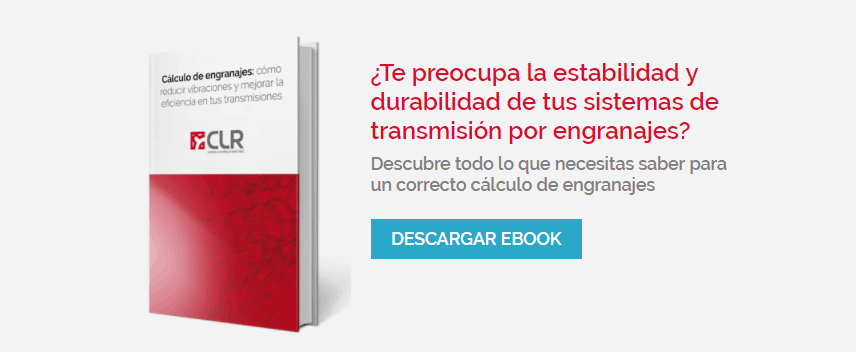
El Use of gears In countless current machines and devices, it is necessary to use them with maximum efficiency, so that they can take full advantage of their advantages.
One of the Key concepts for its good use is that of the gear transmission ratio (rT). Choose wisely the reduction ratio is essential for:
- That the gear can withstand greater torque minimizing the error
- What is it for Generate the movement, so that the torque of the motor gear exceeds the inertia of the gear.
Next we will learn what formulas are necessary for Calculate the gear transmission ratio and what needs to be taken into account for this.
The gear transmission ratio is essential so that the movement can be generated and the gear can withstand the torque without giving an error
What is motion transmission
La motion transmission ratio is the ratio between the rotational speeds of two gears that are connected to each other.
By counting each gear wheel with a different diameter, each of the axles rotates at a different speed when both are running. Changing the transmission ratio is equivalent to changing the torque of force that is applied.
The gear transmission ratio or reduction ratio is calculated by dividing the output speed by the input speed (i= Ws/We) or by dividing the number of teeth on the drive wheels by the number of teeth on the driven wheels (i= Ze/ Zs).
i = Ws/We
i = Ze/Zs
Advantages of gear transmissions
Gear transmissions offer a number of advantages over other types of transmissions. First, they provide a high performance when it comes to transferring forces and movements, with a long lifespan and high reliability.
But what most distinguishes them is their enormous accuracy in the transmission ratio they achieve, which means that they can be used in precision machinery.
The gear transmission ratio is very accurate, making these transmissions perfect for precision machinery
Unlike other mechanisms, such as chains or pulleys, They have small dimensions, which means that they can be installed both in small and large machinery and spaces, as well as in places that are difficult to access.
In addition, its simple maintenance makes gear transmissions one of the most used systems in large industrial sectors, such as the automotive industry.
Parameters for designing the gear transmission
When it comes to carrying out the design of a gear transmission, it is necessary to take into account the following three parameters:
1. Gear condition
It is called the condition of meshing between two teeth, to the situation in which the The point of contact between the two always goes through a point O, so your profile allows it.
That point O must be located on the same line as both the center of rotation of one of the gears as the center of rotation of the other.
In addition, there must be a coincidence between the primitive radii and the distances between the point O and the respective centers.
2. Transmission ratio
The transmission ratio (RT) is the The relationship between the speeds of rotation of the two gears who come into contact.
Specifically, it is about the The ratio between the output speed and the input speed (RT = ΩS /ΩAnd).
The system can be reducing, if the transmission ratio is less than 1, or multiplier, if it is greater than 1.
You might be interested in: Variable speed drives: everything you need to know about gearboxes
3. Coating Coefficient
Also known as contact relationship, the coating coefficient (E) measures the average of teeth that are in contact at all times.
It is established that the ideal coating coefficient must be greater than 1.2 to ensure the ability to transmit high loads, provide stiffness to the transmission and provide a Silent start-up and uniform.

How to calculate the gear transmission ratio
To calculate what the gear transmission ratio is, it can be done in different ways. For example:
Bevel gear transmission ratio calculation
If we talk about conical type gears, we must consider that it will be equivalent to the number of teeth of the drive gear, divided by the number of teeth that the driven gear has (RT= Z1/Z2).
You may be interested in: Gear calculation: Improve the efficiency of your transmissions.
Calculating the transmission ratio of a gear train
In the case of a gear train with two wheels, we must follow the following steps:
- Count the Number of teeth. First of all, we must count the number of teeth in the drive gear and the number of teeth in the driven gear.
- Divide The number of teeth of the driven wheel by the number of teeth on the drive wheel. The resulting number will be the times when the small dragged wheel must rotate for the large one to make a full turn.
The transmission ratio will be equal to the number of teeth of the motor gear divided by the number of teeth of the driven gear.
In the case of a gear train with more than two wheels, we must follow the following steps:
- Identify which is the drive wheel and which is the driven one and dDivide the number of teeth from the first and second. The intermediate wheel does not affect the transmission ratio of the gear train at all.
- Follow the Same steps to find out the transmission ratio that in the case of a gear train with two wheels.
To calculate the gear transmission ratio, there are different ways, depending on whether they are conical gears, gear trains with two or more wheels, etc.
Calculation of the transmission ratio in gears and chain
These types of transmissions are made up of two sprockets and a chain of links articulated. In it, the gears rotate in the same direction.
It is used to transmit the motion between distant parallel axes.
The transmission ratio is the result of Divide the number of teeth in the motor gear by the number of teeth in the driven gear.
Do you need help calculating the ratio of your gear transmissions? Do not hesitate to put yourself in contact us, we'll help you start your project and calculate your parameters.

We offer customized, tailor-made solutions. Configure with us the perfect gearmotor for your project.
¿Tienes un proyecto en mente?
We can manufacture your tailor-made solution, we accompany you at every stage of the project to offer the solution that best suits your application.
Do you have a project in mind?
We can manufacture your tailor-made solution, we accompany you at every stage of the project to offer the solution that best suits your application.








